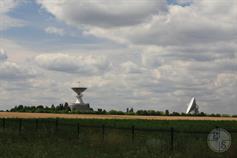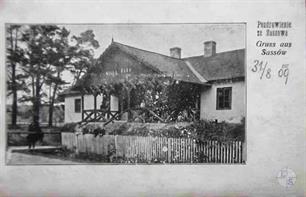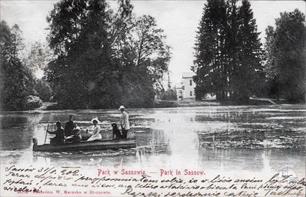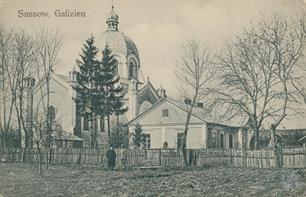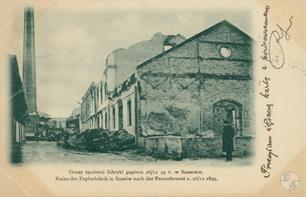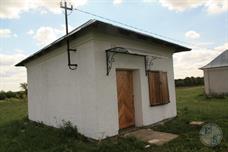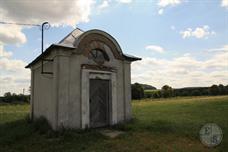Sasiv
Zolochiv district, Lviv region
Sources:
- Russian Jewish encyclopedia
- Jewish encyclopedia of Brockhaus & Efron
Photo:
- Eugene Shnaider
- Photos of Old Lviv. Sasiv and his short history
- Biblioteka Narodowa Polona. Sassow
- Russian Jewish encyclopedia
- Jewish encyclopedia of Brockhaus & Efron
Photo:
- Eugene Shnaider
- Photos of Old Lviv. Sasiv and his short history
- Biblioteka Narodowa Polona. Sassow
The town Sasiv was founded by the Russian governor Ivan Danilovich - the owner of the Olesko Castle, after the permission of King Sigismund III VAZ in 1615 was on the site of the village of Komarovo.
The name of the Sasiv comes from the inscription on the family coat of arms of Danilovich "SAS".
In 1682, Sasov lost Magdeburg's law.
Sasiv received the second life in the 19th century, when he became known throughout the Austrian Empire with his resorts and Aquarius. The most interesting thing is that there were no healing waters in Sasiv, but 300-400 people visited the Aquarius during the summer season. Zolochiv's gentry often came from the city for the evening and concerts that took place in the palace hall.
After the First World War, the resort faded, the hospital and the park were destroyed during the fighting.
From the middle of the XIX century. Sasiv becomes the center of paper production. It was exported to Germany, France, Russia and Turkey. Lviv bought the same paper from Viennese intermediaries who packed it and put a Viennese or French brand.
The name of the Sasiv comes from the inscription on the family coat of arms of Danilovich "SAS".
In 1682, Sasov lost Magdeburg's law.
Sasiv received the second life in the 19th century, when he became known throughout the Austrian Empire with his resorts and Aquarius. The most interesting thing is that there were no healing waters in Sasiv, but 300-400 people visited the Aquarius during the summer season. Zolochiv's gentry often came from the city for the evening and concerts that took place in the palace hall.
After the First World War, the resort faded, the hospital and the park were destroyed during the fighting.
From the middle of the XIX century. Sasiv becomes the center of paper production. It was exported to Germany, France, Russia and Turkey. Lviv bought the same paper from Viennese intermediaries who packed it and put a Viennese or French brand.
In 1764, 223 Jews lived in Sasiv,
in 1880 - 1906 (58.1%),
in 1890 - 1493 (46.5%),
in 1900 - 1761 (46.6%),
in 1910 - 1612 (41,2 %),
in 1921 - 1096 (35.4%),
in 1931 - 1201,
in 1939 - 1150 Jews
Jews lived in Sasiv since the beginning of its founding. In 1637, the Jewish cemetery was esteblished. In 1726, King Jan III, Sobvykh allowed Jews to engage in the tavern, freely trade; public buildings were exempted from all taxes. For the choice of foremen, the Jews represented two candidates, one of which was approved by the owner of the town.
The main affairs of the Jews of Sasiv in the XIX - early XX century was the manufacture of candles and lace (Spanish work - “Shpanish Arbait”). The products of this rare craft were used by Jews to perform religious rites.
Since 1906, the Poalei Zion branch operated in Sasiv.
In 1908, a school financed at the expense of the Baron Hirsch Foundation (102 students).
In the 1920-30s branches of various Jewish parties and organizations acted in Sasov.
On July 2, 1941, the city was captured by the Germans. In the early days of the occupation, 22 Jews were killed. A month later, the Poles and Ukrainians arranged a pogrom, the synagogue was burned.
Jews from the surrounding villages were driven into the Sasov. Jews were busy with coercive work in careers near the town, where many died. About 100 Jews were deported to the Belzhets death camp.
At the end of November 1942, the remaining Jews were transferred to the ghetto of Zolochiv.
in 1880 - 1906 (58.1%),
in 1890 - 1493 (46.5%),
in 1900 - 1761 (46.6%),
in 1910 - 1612 (41,2 %),
in 1921 - 1096 (35.4%),
in 1931 - 1201,
in 1939 - 1150 Jews
Jews lived in Sasiv since the beginning of its founding. In 1637, the Jewish cemetery was esteblished. In 1726, King Jan III, Sobvykh allowed Jews to engage in the tavern, freely trade; public buildings were exempted from all taxes. For the choice of foremen, the Jews represented two candidates, one of which was approved by the owner of the town.
The main affairs of the Jews of Sasiv in the XIX - early XX century was the manufacture of candles and lace (Spanish work - “Shpanish Arbait”). The products of this rare craft were used by Jews to perform religious rites.
Since 1906, the Poalei Zion branch operated in Sasiv.
In 1908, a school financed at the expense of the Baron Hirsch Foundation (102 students).
In the 1920-30s branches of various Jewish parties and organizations acted in Sasov.
On July 2, 1941, the city was captured by the Germans. In the early days of the occupation, 22 Jews were killed. A month later, the Poles and Ukrainians arranged a pogrom, the synagogue was burned.
Jews from the surrounding villages were driven into the Sasov. Jews were busy with coercive work in careers near the town, where many died. About 100 Jews were deported to the Belzhets death camp.
At the end of November 1942, the remaining Jews were transferred to the ghetto of Zolochiv.
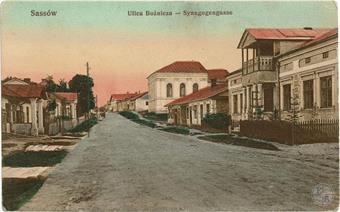 |
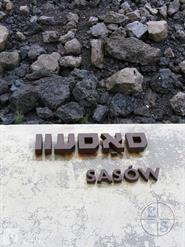 |
| Sasiv, Synagogue street (Synagogengasse). The synagogue is on the right | Memorial inscription in the camp of the death of Belzhets |
At the end of the XVIII century Hasidic courtyard in Sasiv was founded by Rabbi Moshe Jehuda Leib Erblich, a native of the Alesk (Olesko) dynasty. He become the first Sasover Rebe.
The successor of the dynasty was the son of Rebe Moshe Jehuda Leib, Yekutiel Shmuel Shmelke Erblich.
After the death of Shmelke Erblich, his son Jacob Zvi Erblich with the title Rebe from Porozovo became the next Rebe.
The next Rebbe was the son of Yaakov Zvi, Moshe Jehuda Leib Erblich. Moshe Jehuda Leib, named after the founder of the dynasty, was the owner of exceptional hearing and voice, which helped him become a recognized Khazan. Soon the glory about him spread throughout Israel. He served Khazan in Israel, Great Britain, Canada.
Moshe Jehuda Leib combined the leadership of Hasids with professional activities. After the completion of a successful career, Moshe Jehuda Leib settled in the United States in Monsey. After his death, the Sasover Rebe is his son, Jacob Zvi Erblich from Monsey.
The successor of the dynasty was the son of Rebe Moshe Jehuda Leib, Yekutiel Shmuel Shmelke Erblich.
After the death of Shmelke Erblich, his son Jacob Zvi Erblich with the title Rebe from Porozovo became the next Rebe.
The next Rebbe was the son of Yaakov Zvi, Moshe Jehuda Leib Erblich. Moshe Jehuda Leib, named after the founder of the dynasty, was the owner of exceptional hearing and voice, which helped him become a recognized Khazan. Soon the glory about him spread throughout Israel. He served Khazan in Israel, Great Britain, Canada.
Moshe Jehuda Leib combined the leadership of Hasids with professional activities. After the completion of a successful career, Moshe Jehuda Leib settled in the United States in Monsey. After his death, the Sasover Rebe is his son, Jacob Zvi Erblich from Monsey.
In the late 19th century, the descendants of Rabbi Moshe Leib of Sasov had become rabbis in other cities. The town people found themselves without a Rebe. They asked Rabbi Sholom Rokeach, known as the Sar Shalom of Belz, for guidance as to whom to appoint as Rebe. He advised them to nominate his grandson, Rabbi Shlomo, who, although not from the lineage of the Sassover dynasty of Rebe Moshe Leib, appropriated the title "Rebe of Sasov".
Rabbi Shlomo's father was the first Rebe of Alesk (Olesko) and his mother was the daughter of the Sar Shalom. Rabbi Shlomo died in 1919.
Rabbi Lipa Meir Teitelbaum, a great-grandson of Rabbi Shlomo "of Sassov" and the founder of Kiryat Yismach Moshe in Ganei Tikva, in Israel, was the "Sassov"-Keretzky Rebe. In his first marriage, he was the son-in-law of Rabbi Joel Teitelbaum of Satmar. He died in March 1966, and was subsequently succeeded by his two sons (both from his second marriage to Rebbetzin Bluma): Grand Rabbi Yoseph Dovid Teitelbaum, the "Sasover Rebe" in Kiryat Yismach Moshe, and Rabbi Chanoch Henoch Teitelbaum, the "Sasover Rebe" in Monsey, New York.
Thus, in Monsey there are 2 different Sasover Hasidic courtyard at once.
Rabbi Shlomo's father was the first Rebe of Alesk (Olesko) and his mother was the daughter of the Sar Shalom. Rabbi Shlomo died in 1919.
Rabbi Lipa Meir Teitelbaum, a great-grandson of Rabbi Shlomo "of Sassov" and the founder of Kiryat Yismach Moshe in Ganei Tikva, in Israel, was the "Sassov"-Keretzky Rebe. In his first marriage, he was the son-in-law of Rabbi Joel Teitelbaum of Satmar. He died in March 1966, and was subsequently succeeded by his two sons (both from his second marriage to Rebbetzin Bluma): Grand Rabbi Yoseph Dovid Teitelbaum, the "Sasover Rebe" in Kiryat Yismach Moshe, and Rabbi Chanoch Henoch Teitelbaum, the "Sasover Rebe" in Monsey, New York.
Thus, in Monsey there are 2 different Sasover Hasidic courtyard at once.

- Home
- Shtetls
- Vinnytsia region
- Volyn region
- Dnipro region
- Donetsk region
- Zhytomyr region
- Zakarpattia region
- Zaporizhzhia region
- Ivano-Frankivsk region
- Kyiv region
- Kropyvnytskyi region
- Luhansk region
- Lviv region
- Mykolayiv region
- Odessa region
- Poltava region
- Rivne region
- Sumy region
- Ternopil region
- Kharkiv region
- Kherson region
- Khmelnytskyi region
- Chernihiv region
- Chernivtsi region
- Cherkasy region
- Crimea
- Synagogues
- Cemeteries
- Objects & guides
- Old photos
- History
- Contact
Jewish towns of Ukraine
Jewish towns of Ukraine
My shtetl
My shtetl
Donate
